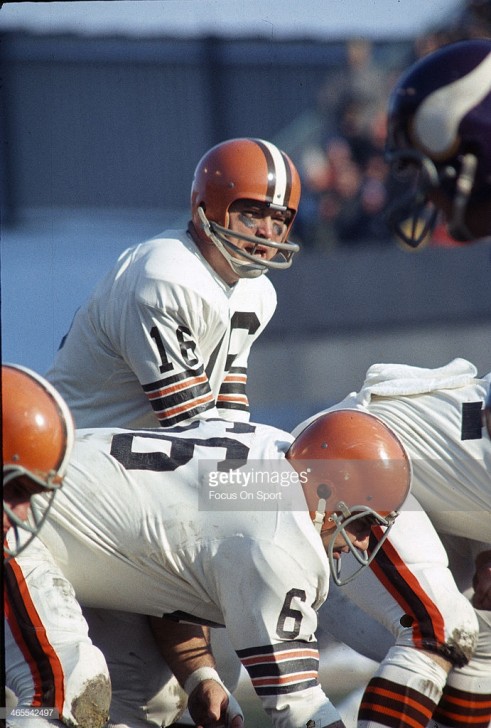This article, from 2019, details my theory as to how the Cleveland Browns, inadvertently, saved pro football in the late 1960s. I’m reposting it as part of my Super Bowl week features, since it has to do with the 2 major Super Bowl upsets won by the AFL during this period.
********************
The beginning of the growth of the National Football League into the popularity monster that it is today goes back to the 1960s and the birth of the AFL/NFL Championship game, orchestrated by the league’s commissioner at the time, Pete Rozelle. A true visionary, he refereed the battle between the old guard NFL owners and the renegade AFL owners, and out of the battle came the merger of the 2 leagues. The agreement spelled out that beginning immediately the rival leagues would hold a common draft of college players, thus ending the bidding war for players that had been going on. Another of the stipulations was that also beginning immediately, the champions of the 2 leagues would play an ultimate title game to decide who was the “world champion”. The merger agreement was made in 1966, but the actual merger itself didn’t begin until 1970. At that time, there were 16 NFL teams and 10 AFL, so 3 of the old guard clubs had to be transferred into the new American Conference. The Pittsburgh Steelers, longtime NFL doormats who perhaps saw an opportunity for more success among the AFL clubs, volunteered to go. Two franchises that had joined the NFL from another league, the old All America Conference, were natural clubs to make the move – the Baltimore Colts and Cleveland Browns. Browns’ owner Art Modell balked at the idea, however, but eventually agreed when Rozelle promised him that his team could host the inaugural Monday Night Football game in that first merger season of 1970.
It wasn’t Modell’s agreement to shift that saved pro football though. It was the Browns team of the late ’60s that had a hand in moving the game forward, in a very weird way in fact. The Browns were a proud, winning franchise in the NFL since joining the league in 1950, and were regular participants in the playoffs most of the decade of the 1960s. In fact, they were in the NFL title game the last 2 seasons before the leagues joined together in 1970. That’s where their contribution to saving the NFL comes in to play. The NFL had always boasted that they were the superior league, and that the AFL was a “Mickey Mouse” league full of castoff players who couldn’t make it in the older league. When the Green Bay Packers dominated the best the AFL had to offer in the first 2 AFL/NFL Championship games, doubt began to creep in on whether the merger was a good idea. The NFL owners’ “Mickey Mouse” comments were appearing to be true, that is, until Joe Namath’s New York Jets and the Hank Stram-led Kansas City Chiefs won the next 2 title contests in what were considered to be massive upsets. Those games gave the AFL a bit of legitimacy, but were they really that great of upsets? Part of the reason the Colts team that Namath beat, and the Minnesota Vikings squad that the Chiefs dominated were considered powerhouses was because they had manhandled the proud Browns franchise in the NFL title games. The Colts shut the Browns out 37-0, and coach Don Shula’s defense was expected to totally crush what was considered to be an inferior Jets’ team in the Super Bowl. The next season, Bud Grant’s Vikings, with CFL reject Joe Kapp at quarterback, completely demolished the Browns in the title game. The final score was only 27-7 but the Vikings controlled play the entire game on a bitter cold day in Minnesota.
So even though the Colts and Vikings had very successful seasons on their way to those Super Bowls, it was their dominance of the Browns that established them as heavy favorites against their supposedly weaker AFL competition. Realistically, though, the Cleveland franchise was in the beginning stages of a gradual decline at that point. Jim Brown, considered the greatest player of all time, had long since retired. LeRoy Kelly had replaced him and was a very good back, a future Hall of Famer in fact, but he wasn’t Jim Brown. More importantly, the quarterback who had guided the Browns to the 1964 title, Frank Ryan, was also gone, forced to retire due to injuries. His replacement, Bill Nelsen, was a gamer who played through injuries and was enough of a leader to get his club into the playoffs, but he wasn’t an elite signal caller. The Browns’ offensive line was aging at the time also, and their defense was a mixture of aging players and inexperienced rookies and young players. So, in a strange way, credit is due to the Browns for making the Colts and Vikings appear to be unbeatable behemoths, who would easily crush, as Vince Lombardi’s Packers had, their AFL opponents. What those Baltimore and Minnesota clubs didn’t realize was that the AFL was already in its’ ninth and tenth years of existence, and the Jets and Chiefs had been built into true championship contenders.

Browns’ QB Bill Nelsen (Getty Images)